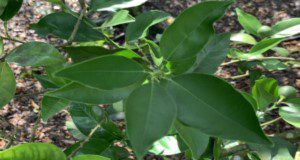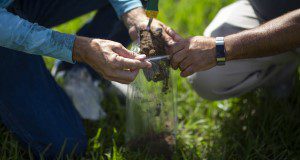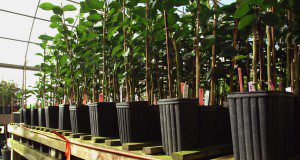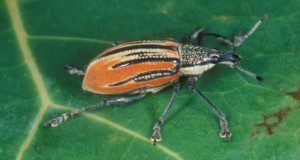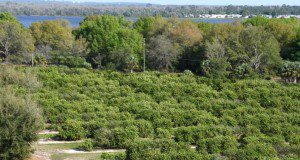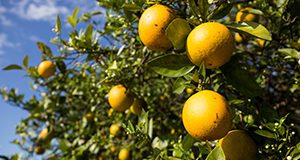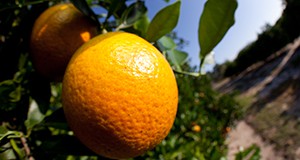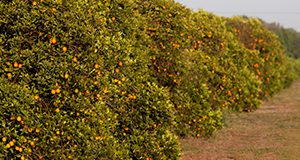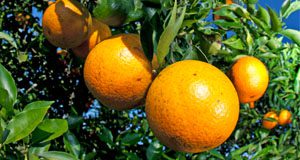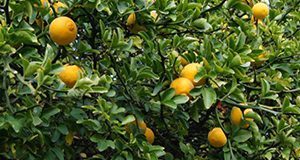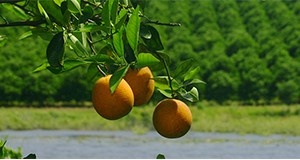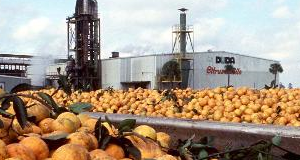To maintain balanced nutrients for optimal tree growth, citrus growers need to assess trees’ nutritional requirements. These assessments help prevent any nutrient deficiency or toxicity from compromising tree health and yield or reducing revenue. This new illustrated two-page instructional sheet gives a basic procedure for the citrus leaf sampling process, as well as additional suggestions for HLB-affected trees. Written by Tripti Vashisth, Jamie D. Burrow, Davie Kadyampakeni, and Rhuanito S. Ferrarezi, and published by the UF/IFAS Horticultural Sciences Department.
https://edis.ifas.ufl.edu/hs1355
Tag: Citrus Research and Education Center
Soil Sampling Procedures
To achieve optimal grove nutrition, citrus growers must test grove soil before beginning any fertilization program. Standard procedures for sampling, preparing, and analyzing soil should be followed for meaningful interpretations of the test results and accurate recommendations. This new two-page fact sheet, published by the UF/IFAS Department of Soil and Water Sciences, provides illustrated soil sampling procedures and tables to aid in basic interpretation of lab results. Written by Davie Kadyampakeni, Kelly Morgan, Arnold Schumann, and Rhuanito S. Ferrarezi.
https://edis.ifas.ufl.edu/ss667
Citrus Soil pH Testing Procedures
Maintaining the correct soil pH is essential to ensure optimal plant growth and crop yield. This new two-page document is an instructional sheet for citrus soil pH testing, written by Kelly Morgan and published by the UF/IFAS Department of Soil and Water Sciences.
https://edis.ifas.ufl.edu/ss665
Rootstock Selection
The large number of different rootstock varieties currently available for citrus production in Florida is unprecedented. This new 4-page article, chapter 4 of the forthcoming UF/IFAS Citrus Nursery Production Guide, provides information on rootstock uses in Florida, rootstock propagation, and the impact of tissue culture, as well as factors to consider when deciding which rootstock to plant. Written by Ute Albrecht, Manjul Dutt, and Jude Grosser and published by the UF/IFAS Horticultural Sciences Department.
https://edis.ifas.ufl.edu/hs1340
Children’s Citrus Activity: Diaprepes Root Weevil
This new two-page children’s activity sheet features pictures of Diaprepes root weevil larva and adults as well as feeding damage. Page two includes a maze. Written by Lauren M. Diepenbrock and Jamie D. Burrow and published by the UF/IFAS Extension 4-H Youth Development program.
http://edis.ifas.ufl.edu/4h403
Children’s Citrus Activity: Citrus Counting
Florida is well known for its citrus industry, valued at over eight billion dollars, and is one of the top citrus-producing states in the United States. This new one-page children’s activity sheet about Florida citrus includes an activity for students learning to count and match. Written by Jamie D. Burrow and Ariel Singerman and published by the UF/IFAS Extension 4-H Youth Development Program.
http://edis.ifas.ufl.edu/4h402
Formation of Citrus Canker Lesions
Citrus canker is a non-systemic bacterial disease that affects citrus trees in both the citrus nursery and in commercial plantings. This poster is designed to assist citrus nursery workers in the identification of citrus canker. This one-page document was written by Jamie Burrow, Megan Dewdney, Ajia Paolillo, and Tim Riley and published by the UF/IFAS Plant Pathology Department.
http://edis.ifas.ufl.edu/pp346
Fertigation for Citrus Trees
Microirrigation is an important component of citrus production systems in Florida. For citrus trees, microirrigation is more desirable than other irrigation methods for several reasons: water conservation, fertilizer management efficiency, and freeze protection. Research has shown that when microirrigation systems are properly managed, water savings can amount to as much as 80% compared with subirrigation and 50% compared with overhead sprinkler irrigation. Research has also shown the important advantage of microsprinklers for freeze protection of citrus. This 4-page fact sheet discusses fertilizer solubility and some common fertigation materials. It also offers a fertigation summary. Written by Mongi Zekri, Arnold Schumann, Tripti Vashisth, Davie Kadyampakeni, Kelly Morgan, Brian Boman, and Tom Obreza, and published by the UF Horticultural Sciences Department, September 2017.
http://edis.ifas.ufl.edu/hs1306
Grove Planning and Establishment
Many factors need to be considered when preparing for new tree plantings. Careful planning and preparation is necessary to ensure success and reduce future frustrations. This three-page document describes the factors that contribute to the success of new grove establishment. Written by Mongi Zekri, Ute Albrecht, Christopher Vincent, and Tripti Vashisth and published by UF’s Horticultural Sciences Department, September 2017.
http://edis.ifas.ufl.edu/hs1302
Managing the Health and Productivity of HLB-Affected Groves
After years of extensive research from across the world, we still do not have a cure for HLB; however, we have learned a lot about this disease, the plant’s response to the disease, and the disease vector. Based on scientific and observational information gathered in the last decade, a number of tools and strategies are currently available for growers to maintain the health and productivity of HLB-affected trees. This four-page fact sheet will shed light on these currently available horticultural inputs and practices that can be implemented immediately by growers to maintain and improve citrus tree health.Written by Tripti Vashisth and published by the Horticultural Sciences Department.
http://edis.ifas.ufl.edu/hs1288
Citrus Nutrition Management Practices
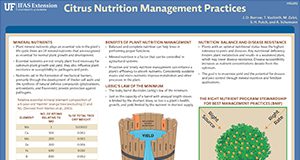
A new two-page fact sheet has been published by the Horticultural Sciences Department and the UF/IFAS Citrus Research and Education Center about citrus nutrition management practices. It was written by J.D. Burrow, T. Vashisth, M. Zekri, S.H. Futch, and A. Schumann.
http://edis.ifas.ufl.edu/hs1292
Citrus Flavonoid Effects on Obesity
The increased prevalence of obesity in recent decades has sparked tremendous concern worldwide. A type of phytochemical, called flavanoids, has been shown in clinical trials to provide significan benefits to overall health because of their antioxidant abilities. Flavanoids are especially abundant in citrus species. This two-page fact sheets describes the health benefits of citrus flavanoids. Written by Yu Wang and Laura Reuss and published by the Food Science and Human Nutrition Department.
http://edis.ifas.ufl.edu/fs285
Evolution of Citrus Disease Management Programs and Their Economic Implications: The Case of Florida’s Citrus Industry
New exotic diseases (citrus canker, HLB, and citrus black spot) have sharply increased the real cost of production of citrus in Florida. Growers have been applying different management strategies, and more effective treatments are being researched. The costs and benefits of these alternatives will need to be quantified to establish their economic feasibility. This 5-page fact sheet written by Ariel Singerman and Marina Burani-Arouca and published by the Food and Resource Economics Department focuses on the costs of managing exotic citrus diseases as they become endemic or established within a citrus industry, with Florida used as an example. The steep increase in the real cost of production of citrus in Florida from 2003/04 to 2014/15 provides evidence that managing endemic exotic diseases is very costly for growers, even without taking into account the effect those diseases have on yields. Therefore, governmental policies focused on preventing the introduction of additional exotic diseases would be highly beneficial for citrus growers and the Florida citrus industry as a whole.
edis.ifas.ufl.edu/fe915
Cost of Production for Processed Oranges Grown in Southwest Florida, 2015/16
This 4-page fact sheet written by Ariel Singerman and published by the Department of Food and Resource Economics presents the cost of production per acre for processed oranges in southwest Florida during 2015/16. Thirteen growers participated in the survey and provided annual, per-acre costs by program for a “typical” irrigated, mature grove (10+ years old), including resets. The number of acres managed by their combined operations accounts for approximately 41,000 acres, of an estimated 257,298 acres devoted to oranges in the area, so the sample represents 16% of the acreage devoted to oranges in that region. Typical users of the estimates in this publication include growers, consultants, property appraisers, and researchers.
http://edis.ifas.ufl.edu/fe1007
Cost of Production for Processed Oranges Grown in Central Florida (Ridge), 2015/16
This 4-page fact sheet written by Ariel Singerman and published by the Department of Food and Resource Economics presents the cost of production per acre for processed oranges in central Florida during 2015/16. Five growers participated in the survey and provided annual, per-acre costs by program for a “typical” irrigated, mature grove (10+ years old), including resets. The number of acres managed by their combined operations accounts for approximately 29,000 acres, of an estimated 137,154 acres devoted to oranges in the area, so the sample represents 21% of the acreage devoted to oranges in that region. Typical users of the estimates in this publication include growers, consultants, property appraisers, and researchers.
http://edis.ifas.ufl.edu/fe1006
Establishment and Production Costs for Southern Highbush Blueberry Orchards in Florida: Enterprise Budget and Profitability Analysis
The United States is the world’s largest producer of blueberries. Florida’s blueberry production represents a small fraction of total US production, but blueberries are nevertheless an important and valuable crop in the state because Florida growers benefit from the nation’s earliest market window. In fact, the average price for blueberries received by growers in Florida during the last three years was 2.5 times the US average.
This 15-page fact sheet written by Ariel Singerman, Marina Burani-Arouca, Jeffrey G. Williamson, and Gary K. England, and published by the UF Department of Food and Resource Economics provides a summary of the enterprise budget developed for highbush blueberry production in Florida. The budget represents a typical operation and serves as an economic benchmark for growers, providing estimates of expenses and potential estimates of revenue and profit for a blueberry crop to help current and potential blueberry growers make informed decisions about blueberry production.
http://edis.ifas.ufl.edu/fe1002
Harvesting Charges for Florida Citrus: Picking, Roadsiding, and Hauling, 2015/16
A survey of Florida citrus harvesters was conducted in July 2016 to collect data and estimate the harvesting charges to Florida citrus growers during the 2015/16 season. This 5-page fact sheet written by Ariel Singermam, Marina Burani-Arouca, and Stephen H. Futch and published by the UF Department of Food and Resource Economics presents the results of the survey, summarizing the harvesting charges for citrus during the 2015/16 season and documenting the changes in harvesting costs as the impact of HLB increases across the state. The estimates presented provide the basis for computing on-tree prices from delivered-in prices, thus allowing the computation of the change in citrus growers’ economic returns as the industry adapts to remain profitable.
http://edis.ifas.ufl.edu/fe1005
Huanglongbing (HLB; citrus greening) and Nutrient Deficiency Identification

Huanglongbing (HLB) is a bacterial disease that is spread by an insect, the Asian citrus psyllid. This two-page fact sheet, which is best viewed as a PDF, http://edis.ifas.ufl.edu/pdffiles/PP/PP32800.pdf, explains how to tell the difference between HLB symptoms and symptoms from nutrient deficiencies. Written by T. Vashisth, M.M. Dewdney, and J.D. Burrow and published by the Plant Pathology Department.
http://edis.ifas.ufl.edu/pp328
Citrus Nutrition UF/IFAS Grower Trials (Pamphlet)
Interested in learning more about citrus nutrition grower trials? This two-page pamphlet provides information on the goals, objectives, benefits, and considerations of the trials as well as specific information about trials being held from 2015-2017. The pamphlet also contains a sign up form for the trials. Written by Tripti Vashisth and Jamie D. Burrow and published by the Horticultural Sciences Department.
http://edis.ifas.ufl.edu/hs1283
Huanglongbing (HLB; citrus greening) Leaf and Fruit Symptom Identification
Huanglongbing (HLB), commonly known as citrus greening, is a bacterial disease that affects all citrus varieties. This two-page fact sheet describes the leaf and fruit symptoms of HLB. Written by Jamie D. Burrow and Megan M. Dewdney and published by the Department of Plant Pathology.
http://edis.ifas.ufl.edu/pp327
